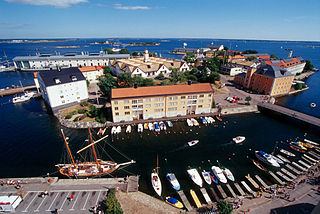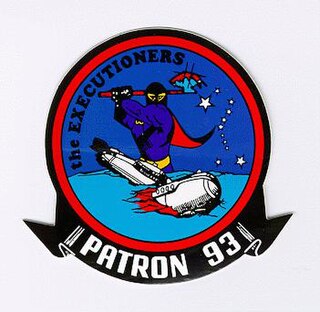
A coast guard or coastguard is a maritime security organization of a particular country. The term embraces wide range of responsibilities in different countries, from being a heavily armed military force with customs and security duties to being a volunteer organization tasked with search and rescue without law enforcement authority. In most countries, a typical coast guard's functions are distinct from those of the navy and the transit police, while in certain countries they have similarities to both.

The Swedish Navy is the maritime service branch of the Swedish Armed Forces. It is composed of surface and submarine naval units – the Fleet, someimes formally referred to as the Royal Navy – as well as marine units, the Amphibious Corps.

The Icelandic Coast Guard is the Icelandic defence service responsible for search and rescue, maritime safety and security surveillance, national defense, and law enforcement. The Coast Guard maintains the Iceland Air Defence System which conducts ground-based surveillance of Iceland's air space and operate Keflavik airbase. It is also responsible for hydrographic surveying and nautical charting.
![<span class="mw-page-title-main">K Line</span> Former Japanese shipping company, now [[Ocean Network Express]]](https://upload.wikimedia.org/wikipedia/commons/b/bf/K-stack.jpg)
Kawasaki Kisen Kaisha, Ltd. is a Japanese transportation company. It owns a fleet that includes dry cargo ships, container ships, liquefied natural gas carriers, Ro-Ro ships, tankers, and container terminals. It used to be the fourteenth largest container transportation and shipping company in the world, before becoming part of Ocean Network Express in 2017.
Underwater Port Security System (UPSS) was developed for the United States Coast Guard and the Maritime Safety and Security Teams (MSSTs) for defense against swimmer incursions. It includes the Underwater Inspection System (UIS) and the Integrated Anti-Swimmer System (IAS). Recent developments in terrorism have highlighted the need for underwater anti-frogman security. The UPSS is made in the United States and is reported to be compact enough fit in a large suitcase.
The United States Coast Guard is the coastal defense, search and rescue, and maritime law enforcement branch of the United States Armed Forces and is one of the country's eight uniformed services. It carries out three basic roles, which are further subdivided into eleven statutory missions. The three roles are:

The Swedish Accident Investigation Authority is a Swedish government agency tasked with investigating all types of serious civil or military accidents that can occur on land, on the sea or in the air. Incidents are also to be investigated if there was a serious risk of an accident. Its headquarters are in Stockholm.

USCGC Fir (WLB-213) is a Juniper-class cutter of the United States Coast Guard. USCGC Fir is under the Operational Control (OPCON) of the Commander of the Thirteenth Coast Guard District and is homeported in Astoria, Oregon. Fir's primary area of responsibility is the coastal waters, river bars and high seas of the Washingtonian and Oregonian coasts. USCGC Fir conducts heavy lift aids to navigation operations, law enforcement and other missions as directed.
The West Cork oil spill was an oil spill off the southern coast of Ireland. The spill was first identified by the European Maritime Safety Agency's CleanSeaNet satellite monitoring system on 14 February 2009. An Irish Air Corps marine patrol aircraft confirmed the slick's presence near the Admiral Kuznetsov which was undergoing refuelling around the same time. The British Coastguard and Irish Department of Transport agreed that around 300 tonnes of oil were spilled. The Russian Navy accepted responsibility for the incident but disputed the quantity, claiming around 20-30 tonnes had been spilt either whilst washing the decks or pumping out the bilges of the carrier, the Russian Navy made no notification to any authority at the time of the spill. The oil spill drifted eastwards and there were fears that the spill would wash up on the coast of south eastern Ireland or Wales but it broke up before this.

An emergency tow vessel, also called emergency towing vessel, (ETV) is a multi purpose boat used by state authorities to tow disabled vessels on high seas in order to prevent dangers to man and environment. The disabled vessel is either towed to a safe haven or kept in place against wind and current until commercial assistance by tug boats has arrived on site or until it has been repaired to the extent of being able to manoeuvre on its own. The need for ETVs as a preventive measure has arisen since the number of available commercial salvage tugs was reduced while potential dangers from individual vessels have increased. E.g. Spain has fourteen, Turkey has eleven, Germany operates eight, Norway has seven, France has five, Sweden three and the Netherlands, Poland, South Africa, Iceland and Finland each have one official emergency tug boat. Australia also operates emergency response vessels. The United Kingdom's four strong ETV fleet was to be disbanded in September 2011 due to budget cuts but the two vessels operating in Scottish waters received an extension of contract until the end of 2011.

The Dutch Caribbean Coast Guard (DCCG) is the coast guard of the Kingdom of the Netherlands in the Dutch Caribbean. The unit is a joint effort between all constituent countries within the Kingdom. Prior to the dissolution of the Netherlands Antilles, it was known as the Netherlands Antilles and Aruba Coast Guard and was a division of the Royal Netherlands Navy.

United States Coast Guard Air Station Houston is a United States Coast Guard Air Station located 15 miles (24 km) southeast of downtown Houston, Texas on board the Ellington Field Joint Reserve Base (JRB).

Stumholmen is a small island to the east of Trossö in Karlskrona, Sweden. It is connected to the center of Karlskrona by the Bastionsgatan bridge. Formerly the property of the Navy, today it houses the National Naval Museum (Marinmuseum), one of Sweden's oldest founded in 1752, the Hyper Island educational complex, and several other historic buildings. The unusual Slup- och barkass- skjulet is noted for its remarkable roof while buildings on Laboratorieholmen once served as an isolation hospital when the town was struck with disease. Comprehensive restoration and renovation work has been undertaken since the 1990s, providing a variety of interesting sights for tourists as well as residential accommodation for senior citizens. Since 1998, the Naval City of Karlskrona, of which Stumholmen is a key component, has been a UNESCO World Heritage Site.

The Joint Arctic Command is a direct Level II authority in the Danish Defence. Joint Arctic Command's primary mission in peacetime is to ensure Danish sovereignty by monitoring the area around the Faroe Islands and Greenland. The command also handles tasks such as fisheries inspection, search and rescue (SAR), patient transport and other tasks that support the civil society. In short, the Joint Arctic Command handles military tasks, coast guard duties and disaster response - all in one organisation.

VP-93, nicknamed the Executioners, was a Patrol Squadron of the U.S. Navy Reserve. It was the second squadron to be assigned the VP-93 designation. The squadron was established on 1 July 1976 and disestablished 18 years later, on 30 September 1994. It flew the Lockheed P-3 Orion, and was based at NAF Detroit during its entire life. Units of the squadron made 17 major overseas deployments.

USCGC Aspen (WLB-208) is the eighth cutter in the Juniper-class 225 ft (69 m) of seagoing buoy tenders. She is under the operational control of the Commander of the Seventeenth U.S. Coast Guard District and is home-ported in Homer, Alaska. Her primary responsibility areas are Kachemak Bay of Cook Inlet to the Kuskokwim River in southwest Alaska and the high seas off south-central and southwest Alaska. Aspen conducts heavy lift aids-to-navigation operations, and law enforcement, homeland security, environmental pollution response, and search and rescue as directed.

USCGC Kukui (WLB-203) is the third cutter in the Juniper-class 225 ft (69 m) of seagoing buoy tenders and is the third ship to bear the name. She is under the operational control of the Commander of the Seventeenth Coast Guard District and is home-ported in Sitka, Alaska. Her primary area of responsibility is the inland and coastal waters of southeastern Alaska. Kukui conducts heavy lift aids-to-navigation operations, and law enforcement, homeland security, environmental pollution response, and search and rescue as directed.
The Swedish Coast Guard consist of 31 larger units, of which 10 are multipurpose ships, 16 maritime surveillance ships and 5 environmental protection ships. In addition to these, there are also five hovercraft, a barge and about 100 smaller boats and jet skis.











![<span class="mw-page-title-main">K Line</span> Former Japanese shipping company, now [[Ocean Network Express]]](https://upload.wikimedia.org/wikipedia/commons/b/bf/K-stack.jpg)









